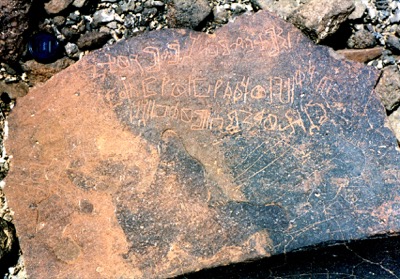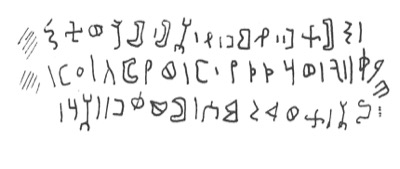Sigla: C 88; Dunand 1379 Script: Safaitic
Transliteration
l s²mt bn nṣr bn ṣn ʾmn mk w ts²[wq] l- bʿls¹my w l- bny dd -h w l- kll qyḥ f ʾlt w ds²r s¹lm w qbll ʾhl
Translation
By S²mt son of Nṣr son of Ṣnʾ the confidant of Mk and he {longed} for Bʿls¹my and the children of his paternal uncle and for every qyḥ so ʾlt and Ds²r let there be security and reunion with family.
Apparatus Criticus
C: ns¹m for nṣr; ʾmn m- ḏ wts² "security for the family of Wts² [?]" for ʾmn mk w ts²[wq] "the confidant of Mk and {he longed }; w l- kl lqyḥ " and for all camels which give birth"; for w l- kll qyḥ " for every qyḥ"; w qbl l- ʾhl "and lodging for the troop" for w qbll ʾhl "and reunion with family".
Commentary
ʾmn could mean either "a confidant" or "a guard". The Nabataean kings Malichus I and II were often called mnkw in Nabataean (e.g. for Malichus I: CIS ii 174 [see Starcky 1985: 169], and for Malichus II: JSNab 10, JSNab 20, etc.). This was written mk in Safaitic with the inconsistent, but quite common, assimilation of n before a following consonant (see Al-Jallad 2015: 51). Thus, the author of C 88 could be claiming to be a confidant, or more likely a guard, of either Malichus I (c. 62/60/58–30 BC) or Malichus II (AD 40–70/71).
The l before kll has a small side stroke at each end, but cannot be a r back-to-front (compare the r in nṣr and ds²r). Similarly the first l of kll has a small side-stroke at the top but cannot be a h (compare the h in dd-h and ʾhl). The k of kll is back-to-front We can offer no explanation for qyḥ.
Subjects
Genealogy
Yearning
Deity
Relatives
Prayer
Country: Syria
Region: Rif Dimashq
Site: Ǧabal Says
Site number: 24
Map reference: 33° 16' N 37° 22' E (OSNG)
Latitude: 33.311133
Longitude: 37.354389
Present Location: In situ
Find date: 1920s and 1930s
Field collector: Maurice & Mireille Dunand
Notes: Ǧabal Says consists of a volcanic cone within a much larger crater. The latter contains the ruins of an Umayyad palace and a semi-permanent lake. De Vogüé (1868–1877: 142–143) found only 2 Safaitic texts (C 3, 3bis) and some Kufic inscriptions by the ruins and Dusaud and Macler found none. None of these seems to have climbed to the top of the inner crater. Von Oppenheim (1899–1900: i, 245), however, reported large numbers on the south-east slope of the inner crater and particularly on its summit, but did not record any. C 5–104 were copied at Ǧabal Says by the Dunands, with no indication of their exact provenance. Safaitic inscriptions and at least one Greek text are to be found all around the rim of the cone and are particularly numerous on the north, north-east and south-east parts, overlooking the lake. Both published (Dunand) and unpublished texts were found on this section of the rim, as well as C 296–298 which are among those (C 292–321) said in C to have come from "the region between Ǧabal Says and Zalaf."
Associated Drawings: An unfinished drawing of a female camel with hairy hump
References:
Al-Jallad, A.M. An Outline of the Grammar of the Safaitic Inscriptions. (Studies in Semitic Languages and Linguistics, 80). Leiden: Brill, 2015.
[CIS ii] Corpus Inscriptionum Semiticarum. Pars II Inscriptiones Aramaicas continens. Paris: Imprimerie nationale, 1889-1954.
Jaussen, A. & Savignac, M.R. Mission archéologique en Arabie. I. (Mars-Mai 1907) De Jérusalem au Hedjaz, Médain Saleh. II. El-ʿEla, d'Hégra à Teima Harrah de Tebouk. Texte et Atlas. III. Les châteaux arabes de Quṣeir ʿAmra, Ḫarâneh, et Tûba. (5 volumes). (Publications de la Société Française des Fouilles Archéologiques, 2). [Reprinted Cairo: Institut Français d'Archéologie Orientale, 1997]. Paris: Leroux/Geuthner, 1909–1920.
[C] Ryckmans, G. Corpus Inscriptionum Semiticarum: Pars Quinta, Inscriptiones Saracenicae Continens: Tomus I, Fasciculus I, Inscriptiones Safaiticae. Paris: E Reipublicae Typographeo, 1950–1951.
[Dunand] Safaitic inscriptions copied by Maurice and Mireille Dunand in the basalt desert of southern Syria in the 1920s and 1930s and published in G. Ryckmans (ed.), Corpus Inscriptionum Semiticarum. Pars V. Inscriptiones Saracenicas continens, Tomus 1. Inscriptiones Safaiticae. (2 volumes). Paris: Imprimerie nationale, 1950-1951.
[JSNab] Starcky, J. Les inscriptions nabatéennes et l'histoire de la Syrie méridionale et du Nord de la Jordanie. Pages 167-181 in J-M. Dentzer (ed.), Hauran I: recherches archéologiques sur la Syrie du Sud à l'époque hellénistique et romaine. (Bibliothèque archéologique et historique, 124.1). Paris: Geuthner, 1985.
URL of this record (for citation): http://krc.orient.ox.ac.uk/ociana/corpus/pages/OCIANA_0003293.html

